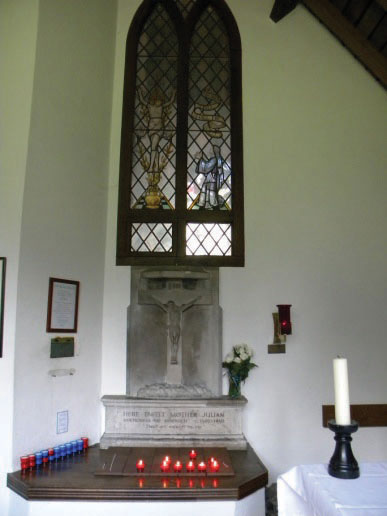This is “Julian of Norwich (1342–1416)”, section 1.6 from the book An Introduction to British Literature (v. 0.0). For details on it (including licensing), click here.
For more information on the source of this book, or why it is available for free, please see the project's home page. You can browse or download additional books there. To download a .zip file containing this book to use offline, simply click here.
1.6 Julian of Norwich (1342–1416)
PLEASE NOTE: This book is currently in draft form; material is not final.
Learning Objectives
- Define the term showing as used in the Middle Ages and explain why it is an appropriate title for the work of Julian of Norwich.
- Account for the Lady Julian’s writing skill in an age in which illiteracy, particularly among women, was common.
Biography
Little is known of the woman now called Julian of Norwich before she became an anchoressa woman called to a contemplative life closed away from other people, a woman called to a contemplative life closed away from other people. As part of her renunciation of her worldly life, she gave up her birth name and adopted the name Julian from the Church of St. Julian in Norwich, England. Julian of Norwich lived in a small room, typical of anchorites and anchoresses, called a cell attached to the church. Unlike many anchoresses, who often had not taken religious orders, Julian may have been a Benedictine nun before beginning her reclusive life.

St. Julian’s Church, Norwich.
An anchoress’s cell typically had a window that opened into the church proper, allowing the recluse to listen to and participate in worship services. Another window would open into a small room where a servant, who took care of her worldly needs, lived, and a third window opened to the outside to allow the anchoress to converse with people who sought her spiritual guidance.

Lady Julian’s cell and the window opening into the church.
According to her own account, when Julian was thirty years old, she suffered a nearly fatal illness. As she recovered she experienced a series of visions. Deciding to become an anchoress, over the next several years she wrote two versions of her Showings of Love.
Text
“Revelations of Divine Love.” Christian Classics Ethereal Library. Calvin College. http://www.ccel.org/ccel/julian/revelations.html
Showings of Love (also known as Revelations of Divine Love)
Although her work bears various titles, Julian chose the word showinga word used in the Middle Ages to describe a manifestation, a revelation, a dream, or a vision, usually of a religious nature, a word used in the Middle Ages to describe a manifestation, a revelation, a dream, or a vision, usually of a religious nature. Her work encompasses her descriptions and explanations of the spiritual insight gained through a series of spiritual visions and visitations she experienced during her severe illness.
In contrast to the teachings of the medieval church and to commonly held beliefs of the Middle Ages, Julian’s writings emphasize the love and compassion of Christ; unlike most people of that era, Julian did not consider illness or suffering a punishment from God but a means of becoming close to God. Rather than emphasizing the fear of damnation in the next world, Julian hoped that all people would be saved from Hell and would receive the blessing of eternal life with God. Also, Julian metaphorically referred to God as both Father and Mother, in opposition to the medieval Church’s paternalistic view of God as Father.
In one of her more well-known passages, Julian describes holding a hazelnut in the palm of her hand and realizing three things from the experience: 1. that God made it; 2. that God loves it; 3. that God keeps it. Perhaps the most recognized quotation from her work is her saying, “All shall be well, and all shall be well, and all manner of things shall be well.”
The British Library provides a digitized view of a medieval manuscript which includes Julian’s work.
Key Takeaways
- Little is known about Julian of Norwich before she became an anchoress and adopted the name Julian.
- Her major work, Showings of Love, is an explanation of the visions she had during a serious illness.
- Some of Julian’s theology conflicts with the teachings of the medieval Church.
Exercises
- Find the medieval definition of showing from the Oxford English Dictionary, and apply the definition to Julian’s works.
- What, according to her comments, is the significance of Julian’s observations about the hazelnut? What other images or metaphors does Julian of Norwich use to express her spiritual insights?
- What aspects of Julian’s life and writings might contradict the traditional teachings of the medieval Church? Speculate on why the Church did not attempt to suppress her writing or to reprimand her for ideas that, from other individuals, might be considered heretical, such as the idea of God as a Mother figure.
Resources: Julian of Norwich
General Resources
- Julian of Norwich 1342-c.1416. Anniina Jokinen. Luminarium. Biographical information, text of Revelations, and scholarly articles. http://www.luminarium.org/medlit/julian.htm
- “Women.” Learning: Medieval Realms. British Library. http://www.bl.uk/learning/histcitizen/medieval/women2/medievalwomen.html
Text
- “Revelations of Divine Love.” Christian Classics Ethereal Library. Calvin College. http://www.ccel.org/ccel/julian/revelations.html
Biography
- “The Beginning of Julian’s Spiritual Vision, in a Collection of Theological Works, including Julian of Norwich.” Illuminated Manuscripts. Online Gallery. British Library. http://www.bl.uk/onlinegallery/onlineex/illmanus/other/011add000037790u00097v00.html
- “Julian of Norwich.” Karen Rae Keck. The Ecole Glossary. The Ecole Initiative. University of Evansville. Brief biographical information. http://ecole.evansville.edu/glossary/juliann.html
- “The Lady Julian and Her Cell.” and “Julian’s Visions.” Julian of Norwich. St. Julian’s Church and Shrine. Information about Julian from the church to which her cell was attached. http://www.julianofnorwich.org/julian.shtml, http://www.julianofnorwich.org/visions.shtml
Manuscript
- “The Beginning of Julian’s Spiritual Vision, in a Collection of Theological Works, including Julian of Norwich.” Illuminated Manuscripts. Online Gallery. British Library. http://www.bl.uk/onlinegallery/onlineex/illmanus/other/011add000037790u00097v00.html
- “The Westminster Cathedral/Abbey Manuscript of Julian of Norwich’s Showing of Love.” Julia Bolton Holloway. Julian of Norwich, Her Showing of Love and Its Contexts. Information on and images of the manuscript. http://www.umilta.net/westmins.html



